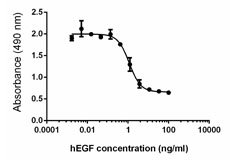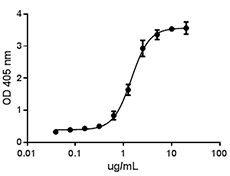- Regulatory Status
- RUO
- Other Names
- IL-1F3, IL-1RA, ICIL-1RA, IRAP, IL-1RN, DIRA
- Ave. Rating
- Submit a Review
- Product Citations
- publications

-

D10.G4.1 cell proliferation induced by IL-1α in the presence of IL-1RA.
IL-1 receptor antagonist, IL-1RA, was initially purified from medium conditioned by human monocytes. IL-1RA belongs to the IL-1 family, which includes 11 members: IL-1α, IL-1β, IL-18, IL-33, and IL-F5 to IL-1F10. Although all members are secreted proteins, IL-RA is the only one that possesses a signal peptide, and it is secreted via the endoplasmic reticulum and Golgi apparatus. In addition to the glycosylated secreted IL-1RA, an intracellular unglycosylated isoform has been described. The two forms of IL-1RA are encoded by a single gene, generated by alternative usage of the first two exons, and their expression is regulated by two promoters. IL-1RA binds tightly to IL-1R1, blocks the binding of IL-1α and IL-1β to the receptor, inhibits the recruitment of IL-1RAP (a receptor accessory protein), and thus the signal transduction induced by IL-1α and IL-1β. IL-1RA also binds to the non-signaling/decoy receptor IL-1RII. IL-1RA exhibits potent anti-inflammatory properties in vivo and can mediate protective effects against inflammatory diseases. IL-1RA has been used in controlled clinical trials for the treatment of rheumatoid arthritis (RA). It has been reported that it reduces clinical signs and symptoms associated with the disease. IL-1RA (Kineret®, Anakinra) has also been used in the treatment of type 2 diabetes and RA.
Product DetailsProduct Details
- Source
- Human IL-1RA, amino acids Met-(Arg8-Glu159) (Accession# NM_000577), was expressed in E. coli.
- Molecular Mass
- The 153 amino acid recombinant protein has a predicted molecular mass of approximately 17.2 kD. The DTT-reduced and non-reduced glycosylated protein migrate at approximately 17 kD and 18 kD, respectively, by SDS-PAGE. The predicted N-terminal amino acid is Met.
- Purity
- >95%, as determined by Coomassie stained SDS-PAGE.
- Formulation
- 0.22 µm filtered protein solution is in PBS, pH 7.2.
- Endotoxin Level
- Less than 0.01 ng per µg cytokine as determined by the LAL method.
- Concentration
- 10 and 25 µg sizes are bottled at 200 µg/mL. 100 µg size and larger sizes are lot-specific and bottled at the concentration indicated on the vial. To obtain lot-specific concentration and expiration, please enter the lot number in our Certificate of Analysis online tool.
- Storage & Handling
- Unopened vial can be stored between 2°C and 8°C for up to 2 weeks, at -20°C for up to six months, or at -70°C or colder until the expiration date. For maximum results, quick spin vial prior to opening. The protein can be aliquoted and stored at -20°C or colder. Stock solutions can also be prepared at 50 - 100 µg/mL in appropriate sterile buffer, carrier protein such as 0.2 - 1% BSA or HSA can be added when preparing the stock solution. Aliquots can be stored between 2°C and 8°C for up to one week and stored at -20°C or colder for up to 3 months. Avoid repeated freeze/thaw cycles.
- Activity
- ED50 = 7 - 35 ng/ml, corresponding to a specific activity of 0.2 - 1.4 x 105 units/mg, as determined by inhibition of D10.G4.1 cell proliferation induced by human IL-1α.
- Application
-
Bioassay
- Application Notes
-
BioLegend carrier-free recombinant proteins provided in liquid format are shipped on blue-ice. Our comparison testing data indicates that when handled and stored as recommended, the liquid format has equal or better stability and shelf-life compared to commercially available lyophilized proteins after reconstitution. Our liquid proteins are verified in-house to maintain activity after shipping on blue ice and are backed by our 100% satisfaction guarantee. If you have any concerns, contact us at tech@biolegend.com.
- Product Citations
-
Antigen Details
- Structure
- Receptor
- Distribution
- Monocytes, neutrophils, macrophages, endothelial cells, corneal epithelial cells, oral mucosa epithelial cells, and fibroblasts.
- Function
- Inhibits the activity of IL-1β and IL-1α by binding to receptor IL1R1 and blocking the downstream signaling.IL-1RA is induced by IL-1, LPS, IgG complexes, IL-4, and IL-10.
- Ligand/Receptor
- Type I and II IL-1 receptors (IL-1RI and IL-1RII).
- Bioactivity
- Inhibition of D10.G4.1 cell proliferation.
- Cell Type
- Hematopoietic stem and progenitors
- Biology Area
- Stem Cells
- Molecular Family
- Cytokines/Chemokines
- Antigen References
-
1. Hannun CH, et al. 1990. Nature 343:336.
2. Cohen S, et al. 2002. Arthritis Rheum. 46:614.
3. Arend WP, et al. 2002. Cytokine Growth Factor Rev. 13:323.
4. Botsios C, et al. 2007. Reumatismo 59:32.
5. Larsen C, et al. 2007. N Engl J Med. 356:1517. - Gene ID
- 3557 View all products for this Gene ID
- UniProt
- View information about IL-1RA on UniProt.org
Related FAQs
- Why choose BioLegend recombinant proteins?
-
• Each lot of product is quality-tested for bioactivity as indicated on the data sheet.
• Greater than 95% Purity or higher, tested on every lot of product.
• 100% Satisfaction Guarantee for quality performance, stability, and consistency.
• Ready-to-use liquid format saves time and reduces challenges associated with reconstitution.
• Bulk and customization available. Contact us.
• Learn more about our Recombinant Proteins. - How does the activity of your recombinant proteins compare to competitors?
-
We quality control each and every lot of recombinant protein. Not only do we check its bioactivity, but we also compare it against other commercially available recombinant proteins. We make sure each recombinant protein’s activity is at least as good as or better than the competition’s. In order to provide you with the best possible product, we ensure that our testing process is rigorous and thorough. If you’re curious and eager to make the switch to BioLegend recombinants, contact your sales representative today!
- What is the specific activity or ED50 of my recombinant protein?
-
The specific activity range of the protein is indicated on the product datasheets. Because the exact activity values on a per unit basis can largely fluctuate depending on a number of factors, including the nature of the assay, cell density, age of cells/passage number, culture media used, and end user technique, the specific activity is best defined as a range and we guarantee the specific activity of all our lots will be within the range indicated on the datasheet. Please note this only applies to recombinants labeled for use in bioassays. ELISA standard recombinant proteins are not recommended for bioassay usage as they are not tested for these applications.
- Have your recombinants been tested for stability?
-
Our testing shows that the recombinant proteins are able to withstand room temperature for a week without losing activity. In addition the recombinant proteins were also found to withstand four cycles of freeze and thaw without losing activity.
- Does specific activity of a recombinant protein vary between lots?
-
Specific activity will vary for each lot and for the type of experiment that is done to validate it, but all passed lots will have activity within the established ED50 range for the product and we guarantee that our products will have lot-to-lot consistency. Please conduct an experiment-specific validation to find the optimal ED50 for your system.
- How do you convert activity as an ED50 in ng/ml to a specific activity in Units/mg?
-
Use formula Specific activity (Units/mg) = 10^6/ ED50 (ng/mL)
 Login / Register
Login / Register 














Follow Us